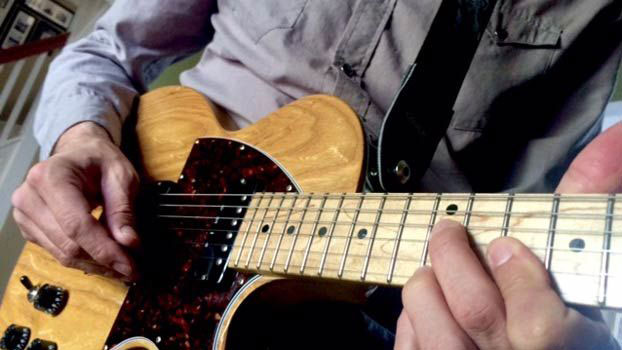Three Licks Incorporating Different Ways of Playing the iim7b5 Chord
Learn some different ways of playing the iim7b5 chord, and some specific ways to connect those voicings to the tonic chord through the V7alt chord in various alterations.

Navigating minor-key chord progressions, especially minor ii V I’s, in a comping or chord soloing context can be tricky when we first learn how to play jazz guitar.
It often seems there are limited voicings for the iim7b5 chord that consistently appears in minor keys, and too many options for the V7alt chord that follows the iim7b5 in a ii V I minor progression.
In today’s lesson, we’re going to look at three different licks, with each using different ways of playing the iim7b5 chord as well as specific ways to connect those voicings to the tonic chord through the V7alt chord in various alterations.
In each of these three licks, I’ve written out the notation and tab to make it easy to get these ideas under your fingers on the fretboard, and I’ve pointed out three to four main points you can take into your practice routine and apply to other chords, musical situations and keys.
Be sure to check out the video lesson below to hear each of these chord licks in action and to get in-depth background on each phrase as well as tips on practicing and applying these ideas in a practical, musical situation.
For more information on playing minor keys for jazz guitar, check out my column, “Using Three Different Scales to Improvise Over Minor Key ii-V-i’s.”
Chord Lick 1 Descending Melody Line
Here are a few key elements to notice in this jazz guitar chord lick:
- Spread Am7b5 voicing
- Descending melody line in bars 1 and 2, G-F-Eb-D
- Descending middle voice in bar 2, G-F#-F-E
Chord Lick 2 Ascending Melody Line
Here are a few key elements to notice in this jazz guitar chord lick:
•Descending chromatic lick on each chord in the melody line
•Ascending nature of the lick as it climbs the neck
•Use of one voicing, based on a m7b5 chord shape, for each chord in the progression

Chord Lick 3 Lenny Breau Voicings
Here are a few key elements to notice in this jazz guitar chord lick:
•Descending melody line, G-F-Eb
•Use of the m11b5 chord in bar 1
•Large, spread voicing for G7alt which is a Db triad over G and B, root and 3rd of G7alt
•The use of CmMaj7 as the I chord in this progression

To hear each of these chord licks and get more in-depth explanation of their background and how to use them in your jazz guitar comping and chord soloing, please view the video lesson below.
3 Minor ii V I Chord Licks Video Lesson
Do you have a favorite minor key ii V I chord lick? Please share it in the comments section below.
Matt Warnock is the owner of mattwarnockguitar.com, a free website that provides hundreds of lessons and resources designed to help guitarists of all experience levels meet their practice and performance goals. Matt lives in the UK, where he is a senior lecturer at the Leeds College of Music and an examiner for the London College of Music (Registry of Guitar Tutors).
Get The Pick Newsletter
All the latest guitar news, interviews, lessons, reviews, deals and more, direct to your inbox!
Matt Warnock is the owner of mattwarnockguitar.com, a free website that provides hundreds of lessons and resources designed to help guitarists of all experience levels meet their practice and performance goals. Matt lives in the UK, where he teaches Skype guitar students all over the world, and is an examiner for the London College of Music (Registry of Guitar Tutors).









![Joe Bonamassa [left] wears a deep blue suit and polka-dotted shirt and plays his green refin Strat; the late Irish blues legend Rory Gallagher [right] screams and inflicts some punishment on his heavily worn number one Stratocaster.](https://cdn.mos.cms.futurecdn.net/cw28h7UBcTVfTLs7p7eiLe.jpg)
